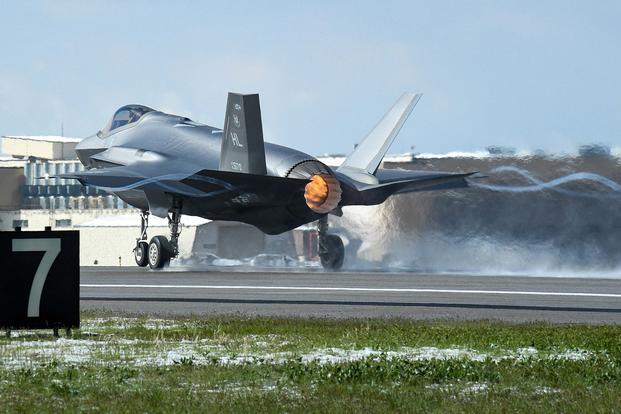F-35 Lightning IIs belonging to Eglin Air Force Base, Florida, and Hill Air Force Base, Utah, have begun using a technology that can help prevent aircraft from flying into the ground, marking a new milestone for the stealth fighter, officials announced Wednesday.
Units at the bases are installing the Automatic Ground Collision Avoidance System, known as Auto-GCAS, seven years ahead of schedule on the F-35A variant, the Joint Program Office and manufacturer Lockheed Martin said in a combined statement.
Auto-GCAS uses sensors that monitor how the aircraft is performing and whether the pilot is still in control. If a pilot loses consciousness, the system kicks in. The sensors that feed into it take into consideration the terrain below, the aircraft's trajectory and speed, and the human inputs, or lack thereof, to calculate how best to recover the jet and bring it down safely, or return it to a smooth trajectory.
The system also comes in handy to prevent controlled flight into terrain, or CFIT, a phenomenon that typically occurs when a pilot becomes disoriented and doesn’t realize the aircraft is on a collision course with the ground.
Related content:
- Aviation Accident Spike Has Services Scrambling for Solutions
- F-35 Tests Out Tech that Keeps Pilots from Crashing Into the Ground
- New Software Will Prevent F-35 Pilots from Flying into the Ground
"This is a great day for the warfighter, as the Auto-GCAS is a proven system that is long overdue," Lt. Gen. Eric Fick, F-35 Program Executive Officer, said in the statement. "Expediting this life-saving technology into the F-35 across the global fleet will bring more warfighters home.
"Over the service life of the F-35 fleet, having Auto-GCAS is estimated to prevent more than 26 ground collisions from happening. It is indeed a remarkable achievement in aeronautics which will improve the performance, efficiency and safety of the F-35. The time and effort expended to deliver this critical warfighting capability is worth it; it will save lives," he added.
In November, the Air Force announced its fifth-generation jet had begun flying with the system during testing flights at Edwards Air Force Base, California. The 461st Flight Test Squadron conducted the flights to see whether Auto-GCAS is compatible with other computer systems on the aircraft.
Auto-GCAS was developed in the 1990s, but early versions had data issues. It was re-engineered between 2003 and 2010 and, by 2016, it had been installed on more than 600 F-16 Fighting Falcon aircraft, "resulting in three confirmed reports that Auto-GCAS saved both the pilot and aircraft," according to the Air Force.
Officials on Wednesday said the system has saved eight F-16 pilots' lives since 2014.
"To accelerate the technology, the Air Force Research Lab and Lockheed Martin conducted positive feasibility studies, and the F-35 Joint Program Office and Lockheed Martin then implemented an agile approach to develop the technology for integration on the F-35," Lockheed said in the statement.
The technology will next be tested and incorporated on the Marine Corps' F-35B and the Navy's F-35C models, according to the release. A timeframe was not provided.
"The safe and effective acceleration of this technology is a testament to the joint government and industry team partnering in an agile environment to deliver life-saving capability to our men and women in uniform, significantly sooner than planned," said Greg Ulmer, Lockheed Martin's vice president and general manager of the F-35 program.
Ulmer told Military.com in September the Auto-GCAS schedule would likely be expedited because Lockheed had begun an "agile construct" where an operator -- such as a pilot -- is "embedded as part of the development team."
Officials have previously noted Auto-GCAS is meant to be used as a backup, not a crutch.
"It's very important they do everything in their power to execute the mission without relying on any safety net to protect them," Lt. Col. Tucker Hamilton, F-35 Integrated Test Force director and 461st commander, said in November during the test trials.
"They've got to execute not thinking it's there. They should execute with that mindset. And then if it saves them, it saves them," he said.
-- Oriana Pawlyk can be reached at oriana.pawlyk@military.com. Follow her on Twitter at @Oriana0214.














